A restaurant marked by dichotomies – culinary excellence and a thoroughly informal setting; a beginning as a casual beach shack and the evolution into one of Italy’s gastronomic temples – Uliassi is full of surprises. Take a journey to the Italian Adriatic Coast and into the mind of chef Mauro Uliassi as he tells the incredible story behind the winner of the Highest New Entry Award, sponsored by Aspire Lifestyles, at The World’s 50 Best Restaurants 2022
When Mauro Uliassi fortuitously discovered his gastronomic talent while cooking at his new wife’s birthday party, his life changed. Having just entered his thirties, he convinced his parents to invest a bit of money into buying a hut on the beach in the city of Senigallia, on the eastern coast of Italy, overlooking the Adriatic Sea. Then, he coaxed his 20-year-old sister Catia into managing the restaurant’s dining room. His ambition was simple: that the restaurant should always be full, lunch and dinner, every day.
It didn’t matter that the building was old and hadn’t been looked after in years, or that you couldn’t even open a window without plaster falling off the walls. The Uliassi siblings cared about what they cooked – and what they cooked brought diners in. In order to keep the restaurant looking decent, every few weeks they applied a fresh coat of paint on the walls, painting over spiderwebs, dust and every other flaw of the dining room.
View this post on Instagram
The Uliassi story begins like this, in 1990, with a casual beachside eatery focused on simple seafood dishes in the hands of a brother-and-sister team with no previous hospitality experience. Thirty-two years and several renovations later, it is now widely considered one of the most influential restaurants in its country. Its innovative, provocative creations have won accolades including ‘Italy’s dish of the year’ several times, and Chef Mauro’s unique, deeply researched style has won over admirers across the world, who flock to an otherwise unassuming seaside town for a taste of his food.
The seeds of a revolution
In the early 1990s, the restaurant’s growing local success meant that the siblings faced a choice: to take their earnings and “buy a Rolex or a Porsche and just act cool”, as Mauro Uliassi puts it, or to invest those earnings back into the business. Over time, they bought new chairs, better glasses and candles for the tables. They repainted the walls not every month but every two weeks, and progressively began an evolution of their cuisine from simple, homecooked meals into something more elaborate.
In 1994, they received a telegram from Michelin. It said: “Congratulations, you have won your first star.” “We couldn’t believe that an institution like that had paid attention to us,” recalls Uliassi. “Our place was a fisherman’s hut that barely stood upright. But it was contrasted by the enthusiasm we had and the passion we put into the things we did. In a way, this dichotomy made us particularly likeable and made the restaurant interesting and fascinating in the eyes of others.”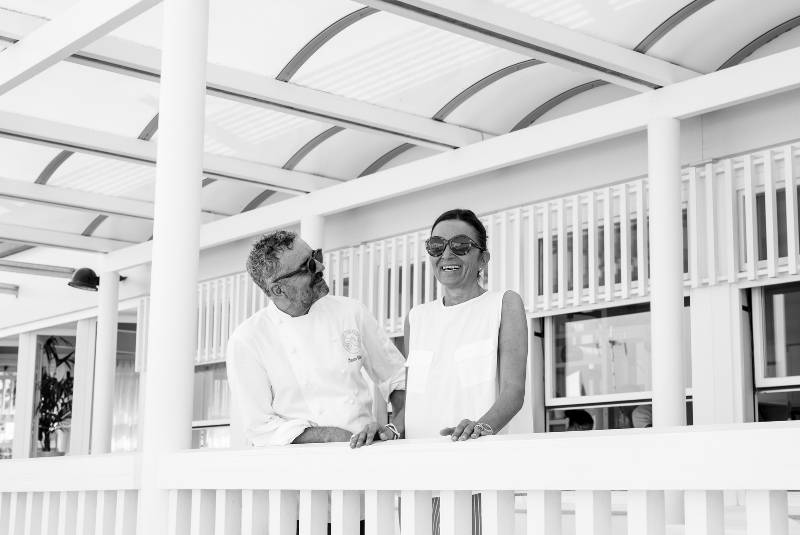
Chef Mauro and his sister, Catia Uliassi, run their eponymous restaurant in Senigallia, on the eastern coast of Italy (image: Alberto Blasetti)
In 1998, he came across an article telling the story of a ground-breaking Spanish chef. Without thinking about it twice, he got in the car with his wife and started driving towards Cala Montjoi. He ate at El Bulli for three days in a row. “I wanted to meet Ferran Adrià at all costs,” he says. “I got down on my knees in front of him. The effect he had on me was explosive, like a vision of the Virgin Mary and all the saints.”
After sending his kitchen team to El Bulli for internships, the chef had the chance to spend three days with Adrià himself, a full immersion into his revolutionary philosophy. He came away having realised that he couldn’t do the same cuisine as Adrià, with his 50-people-strong kitchen and the extreme scientific techniques they applied to their dishes. Instead, he took away something even more important: a renewed enthusiasm for the craft of cooking.
“Ferran gave everyone a kind of energy or aura, which was so powerful that it would make you say: ‘I want to be like him, I want to dedicate myself 100 per cent to this’,” he says. “His message was extraordinary because it was a message of freedom. He told us that there were no rules, that there was nothing except what you really wanted to do, and that you could do new things, because nobody was forcing you to do the same things that others had already done.”
Back in Senigallia, the chef’s process of culinary research and refinement continued. Following El Bulli’s example, he began to close Uliassi for three months a year, during which the culinary team focused on travelling, doing research and development and coming up with a new 12-course menu every year. “The Lab”, as he calls it, has been going strong for nearly 15 years.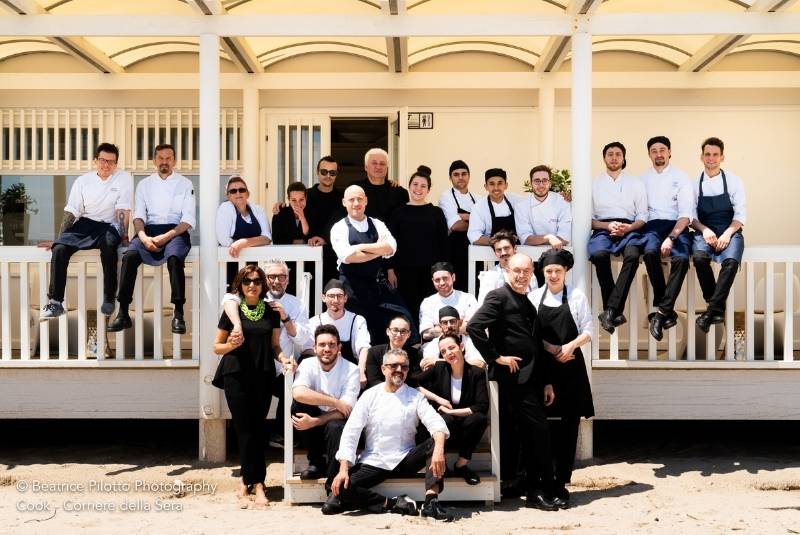
The Uliassi team outside the restaurant (image: Beatrice Pilotto)
Conceptualising Uliassi
Alongside the practical research, Mauro was also developing the philosophy that would come to define Uliassi in the years to come. One of the first concepts he landed on was the contrast of authenticity and contaminazioni, meaning influences or fusions. “Your cultural baggage is tied to your land. In Senigallia, 150 years ago there were only small houses and, behind them, swamps with frogs, snails, eels and game. Now, the people who have moved into the town from many places – Northwest Africa, Bangladesh, Asia, Northern Europe, South America – leave a mark on this baggage. At the same time, your own travels also influence you. So, these things enter you and merge with your knowledge, creating new blends.”
On the other side of the coin, authenticity means to convey something through food that is truly yours – not copying someone else’s life experience because you think it’s fashionable at that time. It’s about “telling a story that belongs to your culture, to your gastronomic history, to the journeys you made. Even though you let yourself be influenced by other experiences, all those elements that can contribute to the profound truth of your dish still need to be there.”
Picture a young Mauro Uliassi, in his early twenties, going out on a Saturday night with his friends in Rimini, the Adriatic Coast’s main party town. They dance until the dawn at Baia degli Angeli, one of the most glamourous and iconic clubs of 70s Italy. Then, they follow the smell of charcoal to the beach, where people set up makeshift barbecues to roast and sell shrimp skewers – the perfect post-clubbing snack, accompanied by an ice-cold beer. The vivacity of this vision is the profound truth Uliassi is talking about, and the real-life inspiration behind one of his best-known creations: Rimini Fest.
“It’s actually made not with shrimp, but with a variety of squid, calamaretti pennini, typical of Rimini. They are breaded, as is tradition in the fish barbecues of the Adriatic coast. The squid skewers are cooked on the grill and accompanied by a mango gazpacho with pineapple, lime, mint and ice. And on top, as the skewers are traditionally seasoned with oil and lemon, are iced shots made with oil, lemon, ginger and garlic. The Rimini Fest is the epitome of the Adriatic Coast, of these skewers and of parties.” The dish, created in 2008, still features on Uliassi’s ‘classics’ menu.
View this post on Instagram
A surprise for the nose
“Now, why do people go to a restaurant?” asks the chef, following this with a pointed pause. “Because they want to enjoy, they want to feel good, they want to have fun. Nobody eats anymore with the peasant hunger of our grandparents. People eat for pleasure and pleasure has different rules: it’s linked to desire and it’s closely connected to the senses.”
Over the last 10 years, Uliassi’s analysis of the senses has led him to a few discoveries. First, that a beautiful dish just isn’t enough. “What you see prepares you for what you taste, so it must be beautiful, but you have to be careful. If there's no taste to support the beauty you've created, then you've already lost at the start,” he says.
Next, he examined the sense of touch as felt through the mouth and the palate, concluding that only a continuous succession of different textures and temperatures – hot, soft, crispy, cold, crunchy – could keep the human brain interested enough during a long succession of courses. Taste, of course, came next: this one was easy, it’s just the ability to balance acid, bitter, sweet and savoury flavours into harmony, a skill he already knew he had when he opened the restaurant.
The final piece of the puzzle was also the most important. “What makes a dish extraordinary and exciting, in the end, is the sense of smell, because it places it in space and time. If you make a beautiful dish that has the right textures and temperatures, that tastes good because you have balanced the flavours, and then you also give it an olfactory element that can be traced back to an emotion that people have experienced in the past, then that dish is no longer only good, but it becomes moving,” he explains.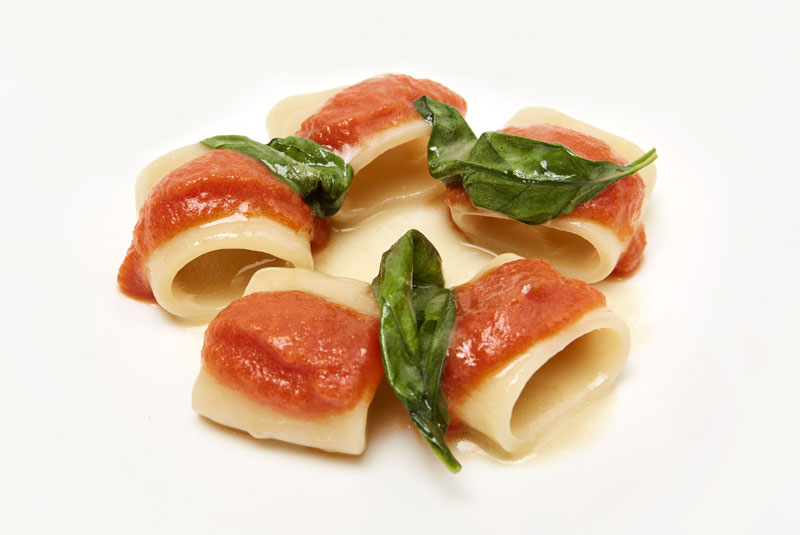
Pasta with tomato sauce à la Hilde
In 2021, Uliassi perfected a dish that he and his team had been working on for nearly eight years. It is pasta al pomodoro – pasta with tomato sauce, one of the cheapest, most famous and most ubiquitous dishes in Italy, cooked by everyone across the whole length of the Boot. “It sounds banal or stupid,” begins Uliassi. “In fact, when we put it on the menu – on the à la carte, it costs 60 euros – we were afraid that people would come and ask us if we were taking the piss! But this is the dish that makes everyone stop and say ‘damn, what a pasta al pomodoro’.
“What’s striking about tomatoes is not so much the taste, but the scent that emanates from the stalks and the leaves, which has this aroma of green, summer and chlorophyll, but when you eat the tomato, it’s gone. Last year, we managed to synthesise this scent with the help of a perfumer called Hilde Soliani. She told us that the same olfactory molecules found in tomatoes are also in fig leaves – so our pasta al pomodoro is seasoned with fig leaf butter.
“Anyone, really, anyone who eats this dish is blown away, because they can suddenly taste this intense scent of tomato leaves that takes them back to their grandmother’s field, or to when they were little, or to the first time they ate tomatoes, or to when they bought them in a market. It reminds everyone of something. That is the ultimate example of how the sense of smell is extremely important when building a dish,” he concludes.
An eye on the future
After that first Michelin star in 1994, the second in 1998 and the third in 2018, Uliassi first appeared on The World’s 50 Best Restaurants’ extended list in 2019, at No.61. In 2021 it climbed to No.52, remaining just outside of the magical group of 50. Then, in 2022, its debut among the top was so momentous that it merited the Highest New Entry Award, sponsored by Aspire Lifestyles. “For us, already being in the 50 Best was an extraordinary thing. But to be in 12th place, to think that there are only 11 restaurants ahead of us in the world, that is something absolutely… we couldn’t have seen it coming.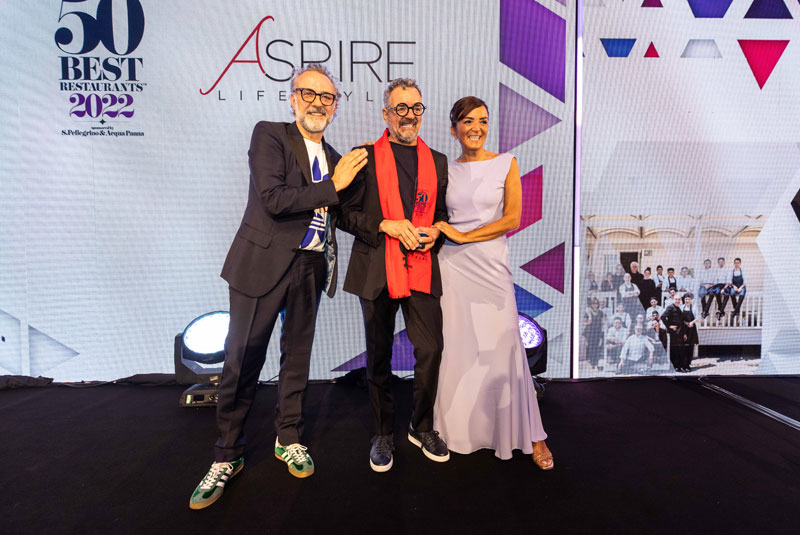
Mauro and Catia Uliassi received the Highest New Entry Award 2022 at The World's 50 Best Restaurants awards ceremony in London from fellow Italian chef Massimo Bottura
“We’ve had these dazed grins stamped on our faces for two weeks, we go to sleep and wake up and still have them. It has unleashed a crazy energy in the restaurant, and the most incredible thing is that it’s also in the customers. People come to the restaurant and thank us, when it should be us thanking them for coming, instead they thank us for creating this wonderful situation. Everyone, from the dishwasher to our suppliers, from our electrician to the carpenter, has been so happy experiencing this new dimension of excellence,” he says.
But through all this, Uliassi never forgets his humble origins. You can still dine at the restaurant in flip-flops and shorts after a day at the beach. On Saturdays, when young people go out on the town just as he used to do in the 70s, diners get a first-class look over the chaos of their lives, thanks to the restaurant’s floor-to-ceiling windows. The chef explains that he likes it because it defuses the situation, highlighting that what’s important is that you experience excellence in the food and in the people who welcome you – the rest is background.
Through his biggest successes and failures, Uliassi has kept a quote by Italian screenwriter Ennio Flaiano top of his mind: “il successo è il passato del verbo succedere”, or essentially, “success is the past of the verb to happen”. “It means that once you’ve had it, it’s already gone,” he reflects. “You always have to reset and look ahead. After all, you are nothing. Only by thinking that you are nothing do you have the possibility of going beyond this nothingness and thus of growing. Because if you crystallise yourself in a dimension of greatness, you are finished.”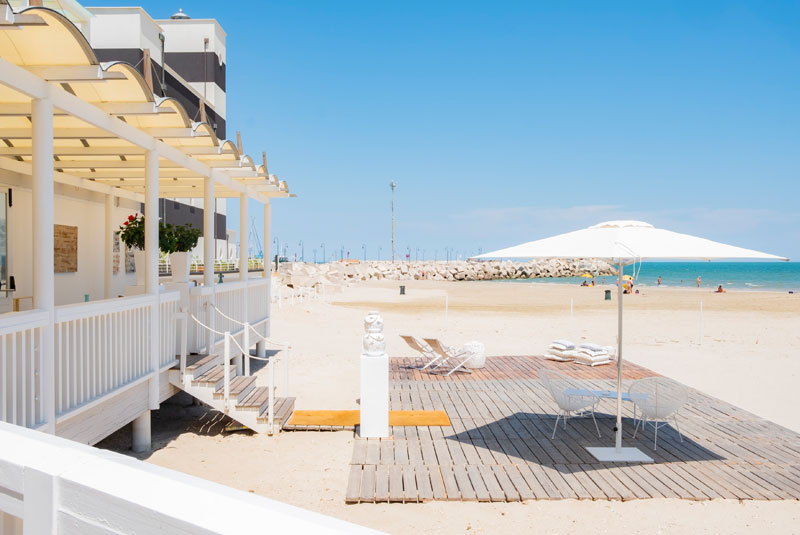
Restaurant Uliassi, overlooking Senigallia's beach
The list of The World's 50 Best Restaurants 2022, sponsored by S.Pellegrino & Acqua Panna, was announced on Monday 18th July at a live awards ceremony in London. To stay up to date with the latest news, follow us on Instagram, Facebook, Twitter and YouTube.

